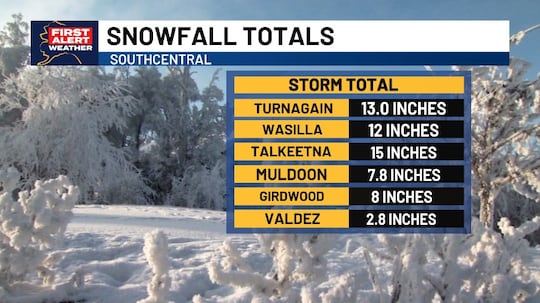Alaska
Alaska Army Guardsman deploying to New Mexico to aid in border security

JOINT BASE ELMENDORF-RICHARDSON, Alaska (KTUU) – Alaska Army National Guardsman will soon head down to the Lower 48 as part of the federal Southwest Border Mission to support U.S. Customs and Border Protection.
The nearly 12-month deployment will bring 20 Alaska-based soldiers and two UH-72A Lakota helicopters to New Mexico. Among the guardsmen are air crews, maintenance technicians, and additional support personnel.
On Monday, a deployment ceremony brought the deployed soldiers’ friends and family to the Alaska National Guard Joint Force Headquarters to celebrate a traditional Army sendoff.
For some of the guardsmen, like Spc. Derek Ruckle — an aircraft maintainer who joined the guard three years ago — this will be their first deployment.
“There’s definitely some nerves, but it’s equal part nerves and excitement,” Ruckle said. “There’s a lot of opportunities for career growth, as well as just experiencing somewhere new.”
The unit of soldiers — known as Detachment 2, C Company, 3-140th Security and Support Battalion — was formed after the Army National Guard received initial notification to prepare for the mission in January.
It’s the second deployment for Sgt. Marvin Caparas, who previously served overseas in Kuwait, Iraq and Jordan. He’ll miss his wife and three kids but feels this deployment will be less challenging, logistically, to keep in contact with them.
“I feel a bit at ease, because I’m still kind of close to them and still within the U.S.,” Caparas said.
Caparas will serve as an aviation fueler during the nearly year-long mission. He’ll be serving alongside several members of the unit who were also on his previous deployment.
The deployment is a first for Spc. Hannah Kinder, a crew chief and maintainer who joined the National Guard just over two years ago. She’s looking forward to the opportunity to work in a new environment alongside her brother, who is also deploying.
“I’m excited for it,” Kinder said. “We’ve both been working side-by-side together, and we both volunteered for this deployment, and I’m excited to go down with him as well.”
Kinder started her career working on Black Hawk helicopters but transitioned her training to the Lakotas over the last five months in preparation for the deployment.
She said the months-long training as also given the chance to bond and learn how to work cohesively together.
The unit will team up with guardsmen from other states to provide aviation support to enhance the mission of the Customs Border Protection’s security operations.
The Detachment’s Commander, Capt. Kyle Johnson, said despite this being his first deployment since joining the National Guard in 2009 — joining Alaska, specifically, in 2021 after serving for over a decade in the Minnesota National Guard — he’s not nervous to lead the unit.
“I probably should be nervous, right? But we have such a good, formidable team that we’ve set up here, I’m honestly not — I think that we’re ready for whatever we need to do,” Johnson said. “I’m really, really confident in our team.”
The crew removed the blades on the two Lakotas and loaded the helicopters onto an Alaska Air National Guard C-17 Globemaster III for transport.
The soldiers are anticipating to leave for the deployment on Friday.
Copyright 2024 KTUU. All rights reserved.

Alaska
Dozens of vehicle accidents reported, Anchorage after-school activities canceled, as snowfall buries Southcentral Alaska

ANCHORAGE, Alaska (KTUU) – Up to a foot of snow has fallen in areas across Southcentral as of Tuesday, with more expected into Wednesday morning.
All sports and after-school activities — except high school basketball and hockey activities — were canceled Tuesday for the Anchorage School District. The decision was made to allow crews to clear school parking lots and manage traffic for snow removal, district officials said.
“These efforts are critical to ensuring schools can safely remain open [Wednesday],” ASD said in a statement.
The Anchorage Police Department’s accident count for the past two days shows there have been 55 car accidents since Monday, as of 9:45 a.m. Tuesday. In addition, there have been 86 vehicles in distress reported by the department.
The snowfall — which has brought up to 13 inches along areas of Turnagain Arm and 12 inches in Wasilla — is expected to continue Tuesday, according to latest forecast models. Numerous winter weather alerts are in effect, and inland areas of Southcentral could see winds up to 25 mph, with coastal areas potentially seeing winds over 45 mph.
Some areas of Southcentral could see more than 20 inches of snowfall by Wednesday, with the Anchorage and Eagle River Hillsides, as well as the foothills of the Talkeetna Mountain, among the areas seeing the most snowfall.
See a spelling or grammar error? Report it to web@ktuu.com
Copyright 2026 KTUU. All rights reserved.
Alaska
Yundt Served: Formal Charges Submitted to Alaska Republican Party, Asks for Party Sanction and Censure of Senator Rob Yundt

On January 3, 2026, Districts 27 and 28 of the Alaska Republican Party received formal charges against Senator Rob Yundt pursuant to Article VII of the Alaska Republican Party Rules.
According to the Alaska Republican Party Rules: “Any candidate or elected official may be sanctioned or censured for any of the following
reasons:
(a) Failure to follow the Party Platform.
(b) Engagement in any activities prohibited by or contrary to these rules or RNC Rules.
(c) Failure to carry out or perform the duties of their office.
(d) Engaging in prohibited discrimination.
(e) Forming a majority caucus in which non-Republicans are at least 1/3 or more of the
coalition.
(f) Engaging in other activities that may be reasonably assessed as bringing dishonor to
the ARP, such as commission of a serious crime.”
Party Rules require the signatures of at least 3 registered Republican constituents for official charges to be filed. The formal charges were signed by registered Republican voters and District N constitutions Jerad McClure, Thomas W. Oels, Janice M. Norman, and Manda Gershon.
Yundt is charged with “failure to adhere and uphold the Alaska Republican Party Platform” and “engaging in conduct contrary to the principles and priorities of the Alaska Republican Party Rules.” The constituents request: “Senator Rob Yundt be provided proper notice of the charges and a full and fair opportunity to respond; and that, upon a finding by the required two-thirds (2/3) vote of the District Committees that the charges are valid, the Committees impose the maximum sanctions authorized under Article VII.”
If the Party finds Yundt guilty of the charges, Yundt may be disciplined with formal censure by the Alaska Republican Party, declaration of ineligibility for Party endorsement, withdrawal of political support, prohibition from participating in certain Party activities, and official and public declaration that Yundt’s conduct and voting record contradict the Party’s values and priorities.
Reasons for the charges are based on Yundt’s active support of House Bill 57, Senate Bill 113, and Senate Bill 92. Constituents who filed the charges argue that HB 57 opposes the Alaska Republican Party Platform by “expanding government surveillance and dramatically increasing education spending;” that SB 113 opposes the Party’s Platform by “impos[ing] new tax burdens on Alaskan consumers and small businesses;” and that SB 92 opposes the Party by “proposing a targeted 9.2% tax on major private-sector energy producer supplying natural gas to Southcentral Alaska.” Although the filed charges state that SB 92 proposes a 9.2% tax, the bill actually proposes a 9.4% tax on income from oil and gas production and transportation.
Many Alaskan conservatives have expressed frustration with Senator Yundt’s legislative decisions. Some, like Marcy Sowers, consider Yundt more like “a tax-loving social justice warrior” than a conservative.
Related
Alaska
Pilot of Alaska flight that lost door plug over Portland sues Boeing, claims company blamed him

The Alaska Airlines captain who piloted the Boeing 737 Max that lost a door plug over Portland two years ago is suing the plane’s manufacturer, alleging that the company has tried to shift blame to him to shield its own negligence.
The $10 million suit — filed in Multnomah County Circuit Court on Tuesday on behalf of captain Brandon Fisher — stems from the dramatic Jan. 5, 2024 mid-air depressurization of Flight 1282, when a door plug in the 26th row flew off six minutes after take off, creating a 2-by-4-foot hole in the plane that forced Fisher and co-pilot Emily Wiprud to perform an emergency landing back at PDX.
None of the 171 passengers or six crew members on board was seriously injured, but some aviation medical experts said that the consequences could have been “catastrophic” had the incident happened at a higher altitude.
Fisher’s lawsuit is the latest in a series filed against Boeing, including dozens from Flight 1282 passengers. It also names Spirit AeroSystems, a subcontractor that worked on the plane.
The lawsuit blames the incident on quality control issues with the door plug. It argues that Boeing caught five misinstalled rivets in the panel, and that Spirit employees painted over the rivets instead of reinstalling them correctly. Boeing inspectors caught the discrepancy again, the complaint alleges, but when employees finally reopened the panel to fix the rivets, they didn’t reattach four bolts that secured the door panel.
The complaint’s allegations that Boeing employees failed to secure the bolts is in line with a National Transportation Safety Board investigation that came to the conclusion that the bolts hadn’t been replaced.
Despite these internal issues, Fisher claims Boeing deliberately shifted blame towards him and his first officer.
Lawyers for Boeing in an earlier lawsuit wrote that the company wasn’t responsible for the incident because the plane had been “improperly maintained or misused by persons and/or entities other than Boeing.”
Fisher’s complaint alleges that the company’s statement was intended to “paint him as the scapegoat for Boeing’s numerous failures.”
“Instead of praising Captain Fisher’s bravery, Boeing inexplicably impugned the reputations of the pilots,” the lawsuit says.
As a result, Fisher has been scrutinized for his role in the incident, the lawsuit alleges, and named in two lawsuits by passengers.
Spokespeople for Boeing and Spirit AeroSystems declined to comment on the lawsuit.
-

 World1 week ago
World1 week agoHamas builds new terror regime in Gaza, recruiting teens amid problematic election
-

 News1 week ago
News1 week agoFor those who help the poor, 2025 goes down as a year of chaos
-

 Science1 week ago
Science1 week agoWe Asked for Environmental Fixes in Your State. You Sent In Thousands.
-

 Business1 week ago
Business1 week agoA tale of two Ralphs — Lauren and the supermarket — shows the reality of a K-shaped economy
-

 Politics1 week ago
Politics1 week agoCommentary: America tried something new in 2025. It’s not going well
-

 Detroit, MI4 days ago
Detroit, MI4 days ago2 hospitalized after shooting on Lodge Freeway in Detroit
-

 Politics1 week ago
Politics1 week agoMarjorie Taylor Greene criticizes Trump’s meetings with Zelenskyy, Netanyahu: ‘Can we just do America?’
-

 Health1 week ago
Health1 week agoRecord-breaking flu numbers reported in New York state, sparking warnings from officials

















